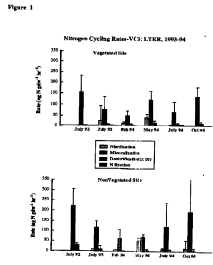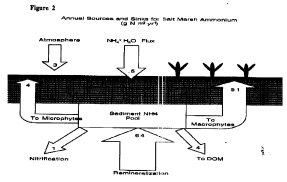
Figure 1 ... Click here for Picture
Figure 2 ... Click here for Picture

Net dissolved inorganic nitrogen (DIN) import / export in salt marsh ecosytems appears to vary with the developmental age of a marsh. Young, accretional marshes have been observed to import DIN from adjacent tidal water, whereas older, mature, erosional marshes export DIN (Childers, et al., 1993; Dame and Gardner, 1993). We have performed seasonal measurements of nitrogen cycling processes, marsh sediment/ tidal water exchanges, and creek water DIN over tidal cycles in a shortSpartina alterniflora marsh located along Phillips Creek on the mainland in the Virginia Coast Reserve LTER site. This salt marsh appears to be in an accretional stage of development (Kastler, 1993). Based upon our nitrogen cycling data we have developed a mass balance model for this salt marsh.
Tidal exchange of DIN was determined in samples taken over 24 hour tidal cycles in Phillips Creek using an ISCO automated sampler. (Berry, et al., 1995). Results demonstrate that Phillips Creek marsh acts as a sink for water column DIN throughout the year. Concurrent with tidal exchange studies we quantified nitrogen fixation, nitrogen mineralization, nitrification, denitrification, and dissimilatory nitrate reduction to ammonium (DNRA) in cores (2 cm) taken at unvegetated creek bank sites and at vegetated sites located approximately 100 m from the creek bank. Nitrogen fixation in the light and dark was measured by acetylene reduction. Mineralization was measured using a 15N- NH4+ pool dilution technique; nitrification by 15N- NO3- pool dilution, and denitrification by 15N2O pool dilution. Partitioning of nitrate reduction into denitrification and DNRA fractions was determined using 15N- NO3- tracer. In addition to measuring N- cycling processes, we used a chamber technique to measure rates of sediment metabolism in the light and dark. We determined above and below-ground plant biomass and C/N ratios as well as sediment C/N. Rate calculations were made for vegetated and unvegetated creekbank marsh areas seasonally over an 18 month period.
We developed a mass balance model for Phillips Creek marsh based upon the following assumptions:
Nitrogen cycling rates from all seasons are shown in Figure 1. Mineralization dominates all N-cycling processes. Rates shown in Figure one are normalized to grams dry weight of sediment. When rates are normalized to sediment surface area and integrated over depths of highest activity, mineralization rates increase five-fold over other N-cycling rates. The mass balance model for Phillips Creek marsh is shown in Figure 2. Mineralization generates 64 gN m-2 y-1. All other sources of N to the marsh including nitrogen fixation, wet atmospheric deposition, and input from tidal water supply approximately 1 gN m-2 y-1. Macrophytes plus microalgae together account for an uptake rate of 55 g N m-2 y-1. Nitrification/denitrification and immobilization account for an additional loss of 5 gN m-2 y-1.

Figure 1 ... Click here for Picture
Figure 2 ... Click here for Picture

We conclude from this mass balance study that a tight coupling exists between DIN production and consumption within this salt marsh community. On an annual basis dissolved inorganic nitrogen produced by mineralization of organic matter supplies the nitrogen necessary to support primary production. We, therefore, expect that there is little export of particulate matter from Phillips Creek marsh.
Berry, B.E., I.C. Anderson, and R.L. Wetzel. 1995. Exchanges of DIN AND DOC between salt marsh sediments and overlying water in Atlantic Estuarine Research Society, Solomon's MD,
Blum, L.K. 1993. Spartina alterniflora root dynamics in a Virginia marsh. Marine Ecology Progress Series. 102: 169-178.
Childers, D.L., S. Cofer-Shabica, and L. Nakashima. 1993. Spatial and temporal variability in marsh-water column interactions in a southeastern USA salt marsh estuary. Marine Ecology Progress Series. 95: 25-38.
Dame, R.F. and L.R. Gardner. 1993. Nutrient processing and the development of tidal creek ecosystems. Marine Chemistry. 43: 175-183.
Kastler, J.A. 1993. Sedimentation and Landscape Evolution of Virginia Salt Marshes M.S. University of Virginia.
Paerl, H. 1995. Coastal eutrophication in relation to atmospheric nitrogen deposition: current perspectives. Ophelia. Proceedings of International Symposium on Nutrient Dynamics in Coastal and Estuarine Environments: in press.